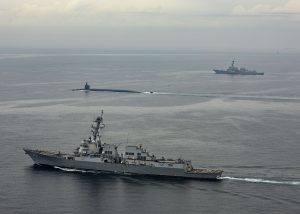From July 18 to 21, the USS Kentucky, a U.S. nuclear-capable ballistic missile submarine (SSBN), visited the port of Busan in the Republic of Korea (ROK). The move provoked a characteristically exaggerated response from North Korea, officially the Democratic People’s Republic of Korea (DPRK), whose defense minister, Kang Sun Nam, suggested that the visit could prompt nuclear retaliation.
Coming amidst the first meeting of the new allied U.S.-ROK Nuclear Consultative Group, the Kentucky’s visit is part of an ongoing effort by the U.S. to “enhance the regular visibility of strategic assets to the Korean Peninsula,” first laid out in the U.S.-ROK Washington Declaration in April. The U.S. Navy emphasized that the port call reflects Washington’s “extended deterrence guarantee” to Seoul. In other words, the visit serves to reinforce the U.S. commitment to defend the ROK with the full range of U.S. capabilities in the event of a DPRK attack. This effort comes amidst growing concerns in the ROK about the viability of the U.S. deterrent given the DPRK’s rapidly expanding nuclear arsenal.
But how exactly does an SSBN port call serve to reinforce the U.S. extended deterrent?
Deterrence theorists emphasize that an effective extended deterrent hinges on perceptions of a defender’s capabilities and credibility. Capabilities refer to a defender’s capacity to impose costs on an adversary should it attack the defender’s ally. Allies and adversaries alike pay close attention to a defender’s capabilities; if they seem lacking, allies may seek protection elsewhere while adversaries may see opportunities for aggression. To shape perceptions of its capabilities, a defender can develop new military assets and forces, reposition its forces, or reveal pertinent information about its forces’ potential.
The USS Kentucky port call obviously does not demonstrate a new military capability; the ROK and DPRK are already both well aware that the U.S. fields a sizeable fleet of 14 Ohio-class SSBNs each carrying a formidable complement of 20 Trident II submarine-launched ballistic missiles. Instead, the visit showcases the potential of the U.S. strategic force, highlighting its combat readiness. In particular, it evidences that the U.S. has SSBNs active and prepared to “fight tonight” in the event of a DPRK attack. Highlighting the readiness of the SSBN fleet is particularly important at the moment given recent reports that as many as 40 percent of U.S. attack submarines are under or waiting for repair.
Additionally, the visit indicates that the U.S. has deployed some of its strategic submarine force to Northeast Asia. While the long-range Trident II is capable of striking the DPRK from a great distance, U.S. SSBNs can respond far more rapidly from nearby in the waters of the Western Pacific. As such, the Kentucky’s port visit should serve to bolster perceptions of U.S. capability in both the DPRK and the ROK.
In addition to capabilities, successful deterrence hinges on credibility. Credibility refers to a defender’s willingness to retaliate against an aggressor even though upholding this commitment may prove difficult and costly. To showcase its willingness to uphold its commitments, a defender can send what deterrence theorists refer to as “costly signals” to friends and adversaries alike. These signals show that the defender is willing to accept considerable costs on behalf of its ally’s defense, costs than an uncommitted state would be unwilling to bear.
The recent port call serves as a costly signal in several ways. Perhaps most importantly, the visit shows that the U.S. is willing to expose, if ever-so-briefly, the location of a remarkably sensitive asset in order to affirm its extended deterrent. The U.S. has previously been reluctant to indicate where its SSBNs are deployed at any given time due to their strategic importance as the most survivable component of the U.S. nuclear triad. Indeed, in recent history U.S. SSBNs have made only a few public port visits, and these visits have been largely limited to U.S. territory and the facilities of its closest ally, the United Kingdom. By announcing the USS Kentucky’s visit to Busan, the U.S. temporarily rendered one of its key assets more vulnerable, showing it is willing to run this risk on behalf of the ROK.
The visit serves as a costly signal for other reasons as well. While the U.S. maintains a fleet of 14 SSBNs, it can only deploy four to five of these assets on deterrence patrols at any given time, with the remainder engaged in training or maintenance. The Kentucky’s trip to Busan therefore carries opportunity costs given the scarcity of U.S. SSBNs on deterrence patrols. As such, this recent port call should bolster the credibility of the U.S. commitment to the ROK.
Ultimately, the USS Kentucky’s port call ultimately serves to reinforce the strength of the U.S. extended deterrent on the Korean Peninsula. As the DPRK works tirelessly to upgrade its growing nuclear arsenal, the U.S. will need to continue to prioritize the increased visibility of U.S. strategic assets to ensure peace and stability on the Korean Peninsula.
The authors’ views are theirs alone and do not represent those of the ROK government.

































